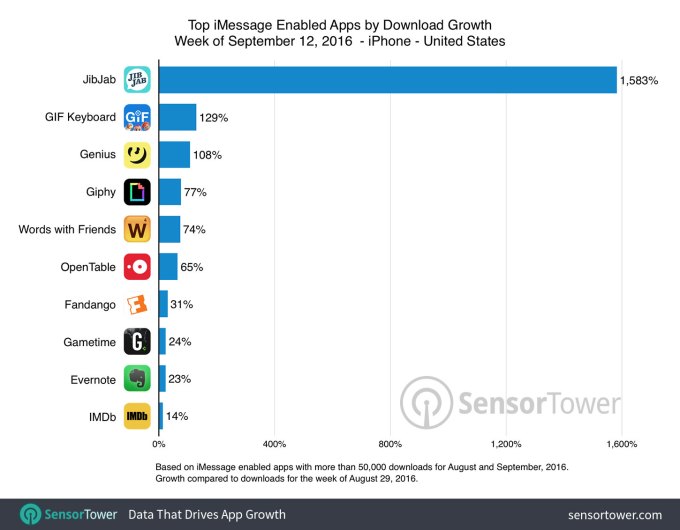iOS 10 may have only reached roughly half of iPhones and iPads so far, but developers who readied their mobile apps for the new iMessage App Store are already benefitting, a new study finds. Existing apps that added support for iMessage have seen their downloads increase significantly, with early movers like JibJab seeing the largest download growth.
With iOS 10, iMessage expanded beyond simple messaging to also become a platform for apps, which includes having its own App Store. Today, new sticker packs and games are dominating the iMessage App Store’s top charts, but pre-existing apps have also seen sizable download growth by rolling out their own support for iMessage interoperability.
According to data from app intelligence firm Sensor Tower, the animated sticker-making app JibJab, whose app has been on the iOS App Store since 2014, saw incredible growth following the launch of iOS 10.
Its download growth was over 1,500% for the week of September 12th – the first week iOS 10 became available to the public for download, the firm found.

This growth is largely due to the fact that JibJab was featured by Apple in the new iMessage App Store. Given that iMessage apps are new, many mobile consumers likely trusted Apple’s recommendations as to which apps to download first.
That being said, other pre-existing apps also saw downloads boosted, thanks to having their iMessage apps ready at launch. This includes Tenor’s GIF Keyboard, whose downloads grew 129%; Genius, whose downloads were up 108%; Giphy, up 108%; Zynga’s Words with Friends, which saw a resurgence with 74% download growth; and others.
Zynga’s apps was also one of the first gaming titles to include iMessage integration – and games are so far proving to be a popular category on the iMessage App Store. Currently, 4 of the top 10 free apps are games, while the #10 paid app is a chess game.
It’s not surprising that iMessage-enabled apps saw a big jump in downloads with the launch of the new App Store, but what we don’t know is how long this growth will be sustained. Nor do we yet know whether this approach is better than others – like rolling out standalone apps or sticker packs, for example – in terms of growing an app’s user base or increasing engagement.
Also of note: Sensor Tower’s study only looked at larger apps with more than 50,000 downloads over the past two months, so this report doesn’t necessarily indicate that merely adding support for iMessage will help a smaller, indie app developer whose app had little prior exposure find an audience.
